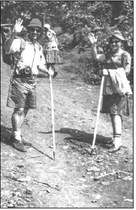Leisure World resident reflects on time spent in Tanzania, Africa


This is the final of a multipart series authored by Mutual 1 resident Deanna Sciaraffa about the experiences of Mutual 3 resident Evie Chapman in Tanzania, Africa. Part 1 ran on Nov. 21, and Part 2 ran on Nov. 28.
by Deanna Sciaraffa
LW contributor
The Mt. Kilimanjaro Climb
The first ascent began at 5,500 feet and would end 12 miles and eight hours later at Gilman’s Point, 18,652 feet.
Evie’s expectations were exceeded beyond her imagination as she spent her first day pushing herself to what felt like the max while climbing in a constant state of breathlessness. She was grateful for the walking stick upon which she relied for support between every step upward. Arrival to the hut where they would spend the night was a great relief even when she learned that everyone would sleep in the same room, a prospect that stunned her.
The little hut included dinner prepared and served by the porters at a table with a tablecloth and linen napkins, leftover items from the years when Britain controlled the region. The porters kept them to use as treats for climbers.
Evie was overcome with muscle soreness and breathing difficulties that included pain.
She made an off-hand comment about feeling as though she was dying. In response a guide provided her with a hot bath in a private space where she could sponge bathe. She was very grateful considering even their water had to be carried by porters throughout the climb. Before she fell asleep, she filled her mind with determination to endure and complete the ascent while devising a new climbing strategy.
I will walk on my own and not hold anyone back.
The next morning Evie started out on her own, walking solo with the intent to let the others know they should not worry about her. She could do this climb! In due course they passed her as she waved another non-verbal message, “Go ahead, I’m OK!” Eventually, except for the guide who trailed behind her, she was the last one in the line of mountaineers. Eight hours later Evie arrived at the second station, Stella Point, named after Estella Latham, the first woman to have reached this point at 18,885 feet. She finished only one hour after the last man in the line of climbers who had passed her on the trail. Along with exhaustion and all the other physical discomforts resulting from the arduous climb, Evie was filled with exhilaration and pride in herself. Once again, the climbers were treated to another sit-down dinner with tablecloth and linen napkins. Stella Point was always very cold at night, with an average temperature range of minus 20 to 20 degrees Fahrenheit during the dry season. There was no heat in the hut. Consequently, they were required to sleep fully clothed with their boots inside their sleeping bags. She began to regard the next day with great anticipation, knowing the summit at Uhuru was so near, within a one-hour climb. She could almost feel its nearness as she settled into sleep. Evie’s naivete was on the verge of betraying her.
The final climb started very early when the climbers were roused at 2:30 in the dead of morning to head for the summit. They were told the reasons why it was important to begin so early:
• The scree (loose stones) was frozen and the ground harder, thus making walking easier.
• To see the sunrise.
• To provide encouragement by subduing the daunting visual of the summit.
They had started the climb in total darkness when Evie noticed the man in front of her had a lantern.
Please, would you turn on your lantern?
The man refused. From that point on climbing involved pushing the walking stick into the ground for every step taken. And for every three steps she completed, Evie was forced to pause and pant. When finally, she made it to the top, she sat on a rock, and with head in hands began to feel sick. Her one thought was to stay calm and relaxed to expedite her recovery. She began to feel stronger as the sun rose and was able to respond when she was encouraged by the guides to take pictures, but because of her stupor she was unable to appreciate the visual impact of the summit.
The climbers were presented with a steel receptacle that contained notebooks. One book was given to Evie to sign and date as a verification that she had completed the climb. When the celebration subsided, the climbers started their descent to return to the second hut with Evie all the while vomiting and feeling sick.
The second-best part of the climb occurred on the next day when the group reached the vegetated zone where the guides made floral crowns for each climber.
Now, Evie had living proof that she had completed the climb! A lovely revelation occurred when the guide who made Evie’s crown revealed himself as the man who refused to light his lantern at the beginning of the climb to the summit. He explained why: “I knew if I had turned it on that you would not have made it to the top.”
He was also the man who explained the importance of climbing in good boots for the prevention of injury and toenail loss associated with pressure exerted in descents. This was the same man who provided her with the hot water at the second hut. He was the man who helped!
Flashback
The return to Musoma and resumption of her normal duties soon overshadowed the glaring memories associated with Evie’s five-day rendezvous with the mountain.
One day she was invited by the compound cook to attend a wedding, a local ritual Evie had never witnessed. Upon arriving to the home, she was impressed by the size of the crowd which included people from Nairobi who were there to be part of the celebration. All guests were required to purchase tickets at the entrance. Shortly after her arrival a scuffle developed over the discovery that someone had stolen a ticket. The suspects included five guests who happened to be sitting near Evie. They were each given a tuft of grass to chew before spitting on command. They were told this test would reveal the guilty party because it would render the thief unable to produce spit. As luck would have it, the man sitting next to Evie was unable to spit. He was searched and the stolen ticket was found in one of his pockets. His penalty included being sold to the other guests to act as their slave by doing whatever they demanded throughout the rest of the celebration and into the night. Now Evie understood the meaning of the idiomatic expression, scared spitless! But she knew from her recent trials to reach the summit that guilt is not the only emotion that demolishes saliva.
A New Challenge
Three years later near the end of her mission 23-yearold Evie was contemplating her future. She travelled back in her mind to the events that brought her to the current moment. She did not go to college and didn’t plan to go to Africa. Her original aspiration was to complete a mission somewhere in the United States but she ended-up instead in Tanzania where she kept asking herself, “How am I going to do this work in Africa?” Were it not for her familiar duties as a bookkeeper, she would have been spinning all by herself upon scree. Her most trusted sources for support, her mother especially, were thousands of miles away in Quakertown. In her correspondences to her family, she avoided speaking about her homesickness and periods of depression. She wrote only cheery letters about positive experiences because she had been taught to be happy and content wherever she was. Considering how much she had learned and achieved in the interim filled her with pride but did very little to nudge her toward a plan for the next step in her life. She decided to confer with the person she most trusted, her boss and church leader.
Ascofu, I think I want to return to my home and go to college.
“For how long, Binti?”
Four years.
“No. If you go you will never come back.”
After much introspection, Evie applied to and was accepted by the college of her choice. In addition, her experience in Tanzania qualified her for a 50% discount of her fees.
Shortly before her departure Evie was deeply touched by her farewell gift from the student pastors, a bu and ankle bells. She knew the tributes represented good wishes as well as great honor.
But Ascofu was right. Evie never returned to Tanzania.
Epilogue
If we were to ask Evie these 60 years later to summarize the life lessons she mastered in Africa, she would say: Climbing the mountain was the first and last athletic thing I have ever done. Challenges are good because they help people do more than they think they can. What is important is to never give up. We must never let others dictate whether or not we will be able to make it to the top. We must fight to get to the top where we will get our crowns that we must wear to the end because that is what Jesus wants us to do.
People look at me and think these things don’t seem to jive with me. My experience was a gift. But I am still climbing that mountain and staying faithful to the end.
Evie Atkinson’s signature is on top of Mt. Kilimanjaro. She carried her name 19,341 feet upward, across five climate zones to assure its delivery. For those who want proof that Evie completed the climb, they themselves will have to ascend the mountain and search in the steel box to find her signature.

Evie and a partner starting the climb.

Dining in the hut, complete with tablecloth and linen napkins.

The summit of Mt. Kilimanjaro.




